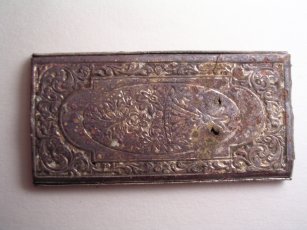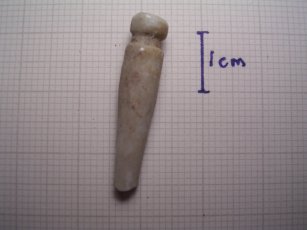Under the floorboards
The original floorboards of the cottages which, combined, now form our house were 8 1/2 inches wide but only 9/16" thick. The ravages of wear, woodworm and poor repairs over a century and a half left many gaps through which everyday items could be lost. Only the rich had carpets; these were certainly not houses for the rich
Later, the cottages became dilapidated. A section of the roof collapsed and dirt and rain got in. Some parts may have been used as storage for the farm. When the building was renovated as a single dwelling, the builders swept some of the accumulated debris into available gaps in the floor.
Whilst repairing floors and installing wiring, we have found many items which give a clue to the lives of past inhabitants. Here are some of the items we have found.
What should this subject be called? "Floorboard archaeology"? "Subsolum archaeology"? ("subsolumology" doesn't sound quite right...)
You can click on any of the photographs to see a larger version; you may need to click the "expand image" icon at lower right of the resulting window to see it full-scale.
New! A heap more objects found under the lounge floor when it was recently repaired. We've not yet had time to write these into a proper webpage, so have used web gallery software to put them on a page at Under the lounge floor. If you know what any of the mystery objects are, please let us know.
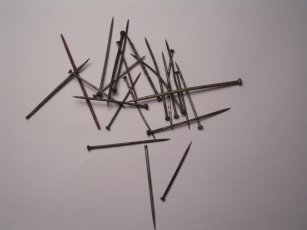 Under the floor of one south-facing room, mixed in with the dirt, were
many pins. These at first appeared to be similar to modern sewing pins,
although slightly smaller. Closer inspection showed that their surface
was blackened but not rusted; a little cleaning on one of them (and a
check with a magnet on the rest) revealed that they are all made of
brass rather than steel.
Under the floor of one south-facing room, mixed in with the dirt, were
many pins. These at first appeared to be similar to modern sewing pins,
although slightly smaller. Closer inspection showed that their surface
was blackened but not rusted; a little cleaning on one of them (and a
check with a magnet on the rest) revealed that they are all made of
brass rather than steel.
This, and the small size of the pins also suggests that they may have been used for lacemaking.
These pins were scattered under much of the flooring, suggesting that they were lost over some period of time, not just swept away when the room was cleared.
One single steel (broken) needle was also found under the floor in this room - it is at the bottom of the photograph.
You can see more detail of the exact size and design of some of the pins in this photograph.
We also found various hairclips and fasteners, which you can see here , and a couple of old cotton reels.
Two large needles, possibly used for stitching canvas, sacking or leather, are here.
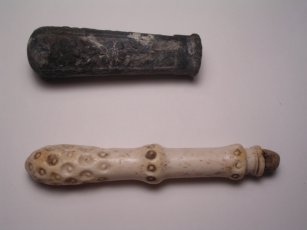 We also found two lacemaking weights - one under the floor of the same upstairs room as the pins,
and one under the floor in the downstairs room immediately below.
This second weight was positioned where it could easily have fallen from the upstairs room via
the gap between the brick wall and lath and plaster drylining.
These weights (one made of bone, the other probably of cast zinc) both have remnants of wood fixed in the open end.
This would originally have been part of the spindle which held the thread.
We also found two lacemaking weights - one under the floor of the same upstairs room as the pins,
and one under the floor in the downstairs room immediately below.
This second weight was positioned where it could easily have fallen from the upstairs room via
the gap between the brick wall and lath and plaster drylining.
These weights (one made of bone, the other probably of cast zinc) both have remnants of wood fixed in the open end.
This would originally have been part of the spindle which held the thread.
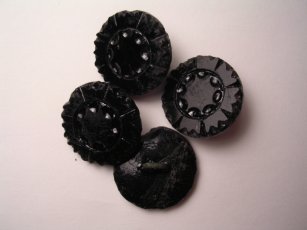 We found several black glass buttons under the floor of the same room as the pins and lacemaking weights.
These were popular in Victorian times, copying the carved jet buttons worn by Queen Victoria.
One can imagine an old lady spending time in front of the south-facing window, making her lace and wearing these buttons.
We found several black glass buttons under the floor of the same room as the pins and lacemaking weights.
These were popular in Victorian times, copying the carved jet buttons worn by Queen Victoria.
One can imagine an old lady spending time in front of the south-facing window, making her lace and wearing these buttons.
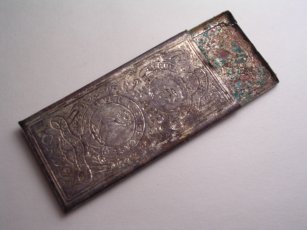 This needle case was under the same floor downstairs as one of the lacemaking weights,
so probably belonged to the same person as the pins etc.
It was so badly corroded and covered in dirt that it was not at first clear what it was,
but some careful cleaning revealed these details.
It appears to be made of copper, but originally had a gold (or maybe gold painted) surface.
The words on the front say "By Royal Letters Patent - SHARPS - The Silver Needle Case -
Cook, Son & Co - London"
This needle case was under the same floor downstairs as one of the lacemaking weights,
so probably belonged to the same person as the pins etc.
It was so badly corroded and covered in dirt that it was not at first clear what it was,
but some careful cleaning revealed these details.
It appears to be made of copper, but originally had a gold (or maybe gold painted) surface.
The words on the front say "By Royal Letters Patent - SHARPS - The Silver Needle Case -
Cook, Son & Co - London"
The large number 5 on the front presumably refers to the number of needles - unless it was a size of needle?
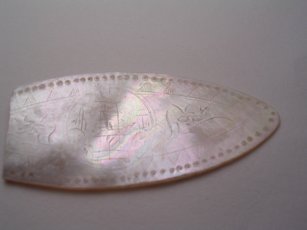 Mother of pearl gaming counter.
(Click on the image to see more detail, or click here
to see detail of the reverse side.)
Mother of pearl gaming counter.
(Click on the image to see more detail, or click here
to see detail of the reverse side.) When we found this, we had no idea what it was, so included a note here asking anyone who knew to contact us. Various ideas came forward, including the possibility that it might be part of a tatting shuttle (used for making a type of lace). Whilst this idea fitted with other objects we'd found, it was ruled out both by the fact that the reverse did not show a mark where it would have been glued to a spindle, and also by its size. Various people suggested that it might be an antique gaming counter. Joshua Schisser then pointed us at an entry (scroll to the very bottom of the page) on "Murph's Musings", Wayne Murphy's blog, showing some rather similar counters. (Murph's main webpage is at www.geocities.com/murph4qs/).
We then emailed Murph, who found an image of an almost identical chip on www.oldtimegaming.com. At the time of writing, that image is on the "chips for sale" page, in the "1800-1820" section, at number 13. This website also includes interesting historical details of these chips.
Now, though, we have the question of how a gaming chip, of the type used by the aristocracy when gambling, ended up in a farm labourer's cottage.
Thank you to all those who contacted us. Clever thing, this internet gizmo!
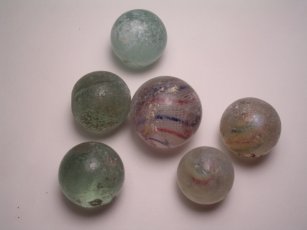 We found marbles of several designs and sizes under the floorboards.
The glass marbles varied from plain glass (some of which may well have originally been the stoppers in old-fashioned lemonade bottles)
to more ornate types. This photo shows a range of types. You can see a little more detail of two of them
here and of another with blue patterns here.
We found marbles of several designs and sizes under the floorboards.
The glass marbles varied from plain glass (some of which may well have originally been the stoppers in old-fashioned lemonade bottles)
to more ornate types. This photo shows a range of types. You can see a little more detail of two of them
here and of another with blue patterns here.
The intricacy of the patterns in these marbles makes modern marbles look a poor imitation. Some of them were probably the prized possessions of boys who lived here. Just where did that marble go?
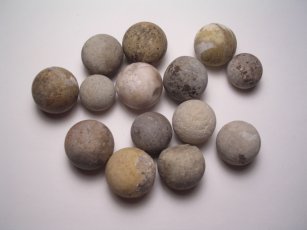 There were also several clay marbles.
It is just possible that these may have been the clay baking beans which are used when cooking an empty pastry pie-crust
- but these were found singly or in small groups, some have a polished surface and they are slightly larger than is now normal for baking beans
- so we are fairly sure that they are marbles.
There were also several clay marbles.
It is just possible that these may have been the clay baking beans which are used when cooking an empty pastry pie-crust
- but these were found singly or in small groups, some have a polished surface and they are slightly larger than is now normal for baking beans
- so we are fairly sure that they are marbles.
 Apart from the marbles, we also found several other small toys. These varied from fairly recent
(the plastic bomb) to apparently very old (the headless wooden sheep).
Apart from the marbles, we also found several other small toys. These varied from fairly recent
(the plastic bomb) to apparently very old (the headless wooden sheep).
 There were also the remains of several dominoes.
They had separated into the wooden base and a thin top section made of bone or ivory.
There were quite a large number of wooden bases, but the only tops are those shown.
They were found on the soil below a downstairs floor, and were covered in damp accumulated dust, so many of the wooden bases had rotted or been attacked by woodworm.
There were also the remains of several dominoes.
They had separated into the wooden base and a thin top section made of bone or ivory.
There were quite a large number of wooden bases, but the only tops are those shown.
They were found on the soil below a downstairs floor, and were covered in damp accumulated dust, so many of the wooden bases had rotted or been attacked by woodworm.
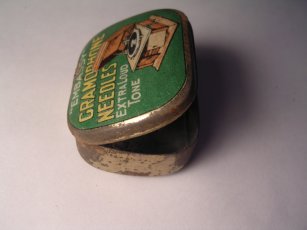 This box once held gramophone needles.
The lid proudly proclaims "Embassy - Gramophone Needles - Extra Loud Tone".
Unfortunately there were no needles with it.
Several of the items we found were associated with people making their own entertainment.
This is doubtless partly because people didn't have television, DVDs or the internet to keep them occupied in days gone by
- though doubtless also due to the fact that small items such as these are easier to lose
(or easier for builders of the future to sweep into holes in the floor).
Whilst future floorboard archaeologists may not find many television sets,
are you quite sure where you put that remote control?
This box once held gramophone needles.
The lid proudly proclaims "Embassy - Gramophone Needles - Extra Loud Tone".
Unfortunately there were no needles with it.
Several of the items we found were associated with people making their own entertainment.
This is doubtless partly because people didn't have television, DVDs or the internet to keep them occupied in days gone by
- though doubtless also due to the fact that small items such as these are easier to lose
(or easier for builders of the future to sweep into holes in the floor).
Whilst future floorboard archaeologists may not find many television sets,
are you quite sure where you put that remote control?
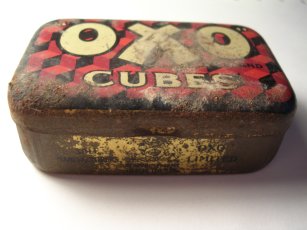 Another small box once held Oxo cubes.
Again, it was empty when found. On the lid it says "OXO Brand Cubes";
The front says "Sole Manufacturers OXO Limited" and "By Appointment to H.M. The King".
The back says "Concentrated Energy of Beef".
Another small box once held Oxo cubes.
Again, it was empty when found. On the lid it says "OXO Brand Cubes";
The front says "Sole Manufacturers OXO Limited" and "By Appointment to H.M. The King".
The back says "Concentrated Energy of Beef".
The underside of the box photograph here has the following text:
"Directions
Put an OXO CUBE into a cup, add hot water and stir.
OXO CUBES dissolve more quickly when cut into thin slices.
To strengthen soups, gravies and entrees, add OXO CUBES as required.
An OXO CUBE in a glass of hot milk renders the milk more easily assimilable.
KEEP THE LID CLOSED
OXO Limited, Thames House, London E.C.4"
It is clear that Oxo cubes have evolved somewhat since then - both in content and in marketing. The idea of cutting cubes into slices is long gone, as is the thought of adding them to hot milk - and when was the last time that you saw the word "assimilable" on any kind of pack?
If you are really interested, there is a lot more historical information about Oxo at OXO History
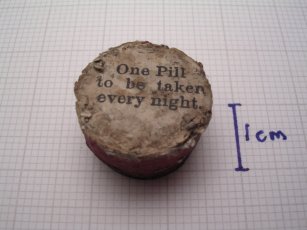 This pill box is very small - the 1cm marking in the photograph gives an idea of scale.
It must either have contained very small pills or a very small number.
Perhaps the pills were sleeping pills and were so toxic that the druggist only dispensed a few at a time. Or maybe they
were so expensive that the purchaser could only afford to buy a few.
This pill box is very small - the 1cm marking in the photograph gives an idea of scale.
It must either have contained very small pills or a very small number.
Perhaps the pills were sleeping pills and were so toxic that the druggist only dispensed a few at a time. Or maybe they
were so expensive that the purchaser could only afford to buy a few.
 Who left this Cadbury's Dairy Milk chocolate wrapper under the floorboards? Was it evidence of a
midnight snack, pushed between the boards to hide it? Maybe a hungry electrician or gas pipe installer
left it - or maybe it's just another bit of rubbish that was swept or fell through a hole in the floor.
Who left this Cadbury's Dairy Milk chocolate wrapper under the floorboards? Was it evidence of a
midnight snack, pushed between the boards to hide it? Maybe a hungry electrician or gas pipe installer
left it - or maybe it's just another bit of rubbish that was swept or fell through a hole in the floor.
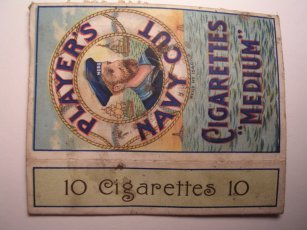 No health warnings when these cigarettes were smoked. "Rich, Cool", it says - at least they're not claimed to cure colds!
The fact that it says "Imperial tobacco company" gives some clue to its age - ITC was formed in 1901 as a consortium of 13
major UK companies, apparently in response to the new threat posed by American interests in the UK market. Health warnings
on cigarette packs were introduced in the UK in 1971. If you can identify the age of this pack more
exactly, please let us know. You can see the reverse of the pack here.
No health warnings when these cigarettes were smoked. "Rich, Cool", it says - at least they're not claimed to cure colds!
The fact that it says "Imperial tobacco company" gives some clue to its age - ITC was formed in 1901 as a consortium of 13
major UK companies, apparently in response to the new threat posed by American interests in the UK market. Health warnings
on cigarette packs were introduced in the UK in 1971. If you can identify the age of this pack more
exactly, please let us know. You can see the reverse of the pack here.
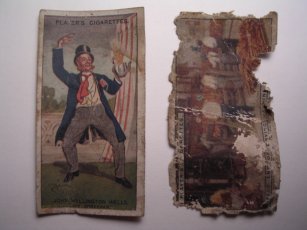 Maybe these cigarette cards were of a similar vintage to the pack? The reverse of the cards is here. A little research shows that the card depicting the Gilbert and Sullivan character John Wellington Wells was from a set issued in 1925, and that the "From Plantation To Smoker" set was issued in 1926.
Maybe these cigarette cards were of a similar vintage to the pack? The reverse of the cards is here. A little research shows that the card depicting the Gilbert and Sullivan character John Wellington Wells was from a set issued in 1925, and that the "From Plantation To Smoker" set was issued in 1926.
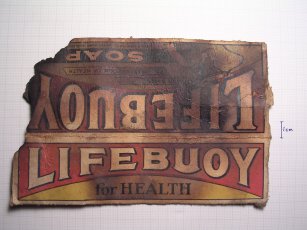 This Lifebuoy Soap wrapper clearly predates modern restrictions on the wording of product claims.
The reverse of the wrapper, which can be seen here
says "£1000 Reward Will be given to any person who can prove that this soap contains any form of
adulteration whatsoever or contains any injurious chemicals". It also suggests that the soap be used
for washing hands, bathing, washing clothes, boiling clothes and for general household cleaning.
This Lifebuoy Soap wrapper clearly predates modern restrictions on the wording of product claims.
The reverse of the wrapper, which can be seen here
says "£1000 Reward Will be given to any person who can prove that this soap contains any form of
adulteration whatsoever or contains any injurious chemicals". It also suggests that the soap be used
for washing hands, bathing, washing clothes, boiling clothes and for general household cleaning.
 The final "paper artefacts" photo we're including on this page is this paperback cover.
It is obviously a rather cheap "pulp fiction" type paperback. Some quick research on the interweb reveals that it was published in 1922, and that the author, May Dalton, wrote a series of books with similarly titliiating titles.
The inside of the cover is here
The final "paper artefacts" photo we're including on this page is this paperback cover.
It is obviously a rather cheap "pulp fiction" type paperback. Some quick research on the interweb reveals that it was published in 1922, and that the author, May Dalton, wrote a series of books with similarly titliiating titles.
The inside of the cover is here
Other paper and card objects found include a page from an English grammar textbook ;this photograph card , though unfortunately the photograph was missing from the front of the card; and this page from the "Radio Times" showing BBC TV programmes on October 5th 1966.
 This brooch incorporates a photograph of a couple dressed in Edwardian style. Maybe one of them lived here and lost the brooch?
This brooch incorporates a photograph of a couple dressed in Edwardian style. Maybe one of them lived here and lost the brooch?
 These buttons obviously came from many different garments; they were found in
various parts of the house.
These buttons obviously came from many different garments; they were found in
various parts of the house.
The rather motheaten one at top right is a leather button, as sometimes seen on tweed jackets.
The golden coloured button appears to show a stylised lion's head; the reverse says "Firmin's London".
The button at top left is metal, possibly brass on the front, but made in two sections and therefore hollow.
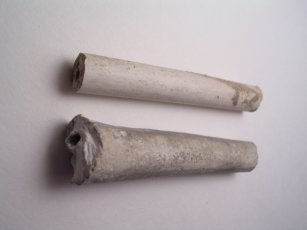 We're not sure when clay pipes stopped being used. These fragments are the only ones we found,
suggesting that a pipe was dropped and only the smaller pieces fell between the floorboards.
We're not sure when clay pipes stopped being used. These fragments are the only ones we found,
suggesting that a pipe was dropped and only the smaller pieces fell between the floorboards.
 Were these seashells a treasured memento of a rare family trip to the seaside by steam locomotive, or just a more recent bit of unimportant debris?
Were these seashells a treasured memento of a rare family trip to the seaside by steam locomotive, or just a more recent bit of unimportant debris?
 We think that this was a toothbrush.
The handle is made of bone or ivory; the bristles have disappeared so were probably natural bristle.
We think that this was a toothbrush.
The handle is made of bone or ivory; the bristles have disappeared so were probably natural bristle.
The marking on the handle has an unidentifiable manufacturer's mark, but also says "silver wire". This probably refers to the wire used to retain the bristles, which is still visible in the rear of the head of the brush.
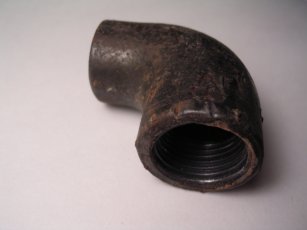 Under some of the upstairs floors were gas pipes remaining from the time when parts of the cottages
had gas lighting.
Under some of the upstairs floors were gas pipes remaining from the time when parts of the cottages
had gas lighting.
The main pipes were steel, but sections which ran to individual light fittings were a narrow gauge of lead pipe. None of the original light fittings remained, all the pipes had been disconnected and some had been removed before we moved here. This is simply one of the joints from the steel pipework.
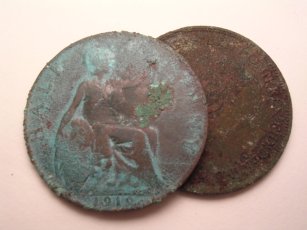 These halfpennies were doubtless worth much more when they were lost. They were both found
under the floor of the downstairs front room of one of the cottages. One is dated 1919; the date on the other
is too corroded to read, but it is from the reign of King George 5th (1910 - 1936).
These halfpennies were doubtless worth much more when they were lost. They were both found
under the floor of the downstairs front room of one of the cottages. One is dated 1919; the date on the other
is too corroded to read, but it is from the reign of King George 5th (1910 - 1936).
A penny, and a half new penny (photo) were found under floors upstairs. The UK changed from the old (pounds, shillings and pence) coinage to the new (100 new pence = one pound) in 1971.
 We wondered whether this might be a plum-bob, used when hanging wallpaper. It was included at the end of this page as a bit of a mystery, until Chris Jahn emailed us with some thoughts and questions. This prompted us to clean it up some more, which revealed that it was designed to open....
We wondered whether this might be a plum-bob, used when hanging wallpaper. It was included at the end of this page as a bit of a mystery, until Chris Jahn emailed us with some thoughts and questions. This prompted us to clean it up some more, which revealed that it was designed to open....
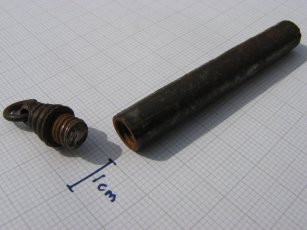 ... a degree of persuasion was needed, but it finally opened, to reveal - nothing.
... a degree of persuasion was needed, but it finally opened, to reveal - nothing.So the mystery remains. What was it for? A couple of people have suggested that it my well have been a needle case (for sewing needles), but any other thoughts are welcome.
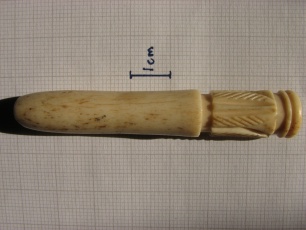 Again, we're uncertain what this is - it may be the bone handle from a pen, but please let us know if you have other ideas.
Again, we're uncertain what this is - it may be the bone handle from a pen, but please let us know if you have other ideas.
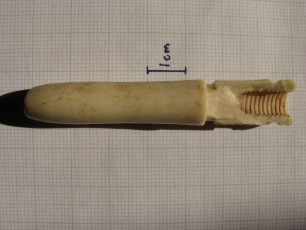 This is the other side of the object - the damaged area reveals the thread within the end - so it must have been designed to fit onto something....
This is the other side of the object - the damaged area reveals the thread within the end - so it must have been designed to fit onto something....
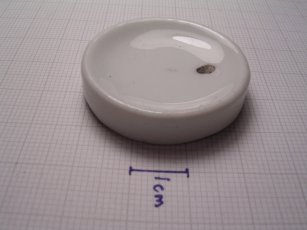 These two pottery items were also in the list of mysteries at the end of the page, but Chris Jahn said that they are very much like a miniature mortar and pestle which his grandmother used to use for grinding aspirin pills to a powder "to facilitate digestion".
These two pottery items were also in the list of mysteries at the end of the page, but Chris Jahn said that they are very much like a miniature mortar and pestle which his grandmother used to use for grinding aspirin pills to a powder "to facilitate digestion".
 Finally, having referred to all the things lost by previous residents, we thought you'd like to meet
another previous resident, shown along with some of the things he left, and his friend Yoric.
(The nuts in the photo are those referred to in the warning on the front page.)
Finally, having referred to all the things lost by previous residents, we thought you'd like to meet
another previous resident, shown along with some of the things he left, and his friend Yoric.
(The nuts in the photo are those referred to in the warning on the front page.)
- A pencil produced by a now unidentifiable friendly society
- Maybe this is the metal rose from a toy watering can?
- A metal ring - looks like a metal frame with a hinge. Probably brass, and might have had leather inserts, to hold two photographs, but which have since rotted.
- A nailfile. Modern style, so probably a fairly recent addition to the underfloor world.
